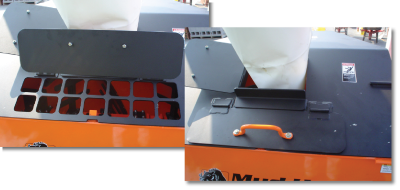If you guessed a pumpkin, you’re right. It is almost Halloween, of course!
But the answer I was looking for was a Mud Hog, one of the many fabulous creations by EZG Manufacturing. Read below on how these bad boys can help you out.
MH12- Mud Hog
At a time when everyone is scrambling to meet the requirements of the recently updated OSHA silica regulations, many are still asking what is supposed to happen with the mixing stations. OSHA conveniently (or not-so-conveniently) left this out of Table 1. Because of this, there’s no guidance of what is to be done here.
So, what’s a contractor to do?
- Pause for a minute before agreeing to use respirators (N95 most likely). There’s a chance the General Contractor will assume this is what should be done but this opens a whole can of worms (and medical exams, fit testing, and paperwork) that you probably don’t want to do unless absolutely necessary (note: that there are some activities within Table 1 that may require it).
- See our blog on Voluntary Use of Respirators for more information on this subject.
- Determine how you’re mixing your mortar. Are you:
- Using a silo system with pre-mixed mortar
- Using pre-mixed mortar in smaller, most likely in 80 lb, bags
- Batching (field mixing) everything
- Check with your supplier or masonry association to see if you’ve got any access to objective data to show you’re under the limit.
- If you’re buying pre-mixed mortar, you may be able to get testing that is similar to what you’re doing from your suppliers. This will likely need to be in the same general region as you are working or the mix design and conditions could be different, causing OSHA to not accept it as objective data.
- Check with your local or state association to see if there’s any objective testing available for either pre-mixed or batching.
- If you can’t get objective data that works for the way you’re mixing, you can perform testing of your own but be careful to follow all steps and requirements for testing, including posting results, allowing employee representatives, etc.
- If you’re over the PEL, you’ll need to determine what respirator your employees need to wear and follow the guidelines of the respiratory protection standards.
- Stay tuned in to MCAA and with your suppliers.
- Manufactures, like EZG, are actively working to develop solutions to help contractors keep working, despite these new and challenging requirements.
- If you have ideas on creating better ways to handle these issues, partner with your manufacturers or suppliers to develop these solutions, when possible.
Regardless of whether you have the data to show you are under the PEL or not, if you’re making a big cloud of dust at your mixing station, you could still be a target of OSHA and/or the General Contractor’s safety person.
Why does that matter?
- Both groups can (and probably will) stop work until you can prove otherwise.
- If your mixing station shuts down, you’re not going to be laying units for much longer.
- It could take you a bit to find the necessary paperwork- so the easier access your crews have to all documentation, the better.
- If OSHA finds one area that they see a lot of dust, they will probably look at every other area that there is potential dust. Ask yourself the following:
- How confident are you that your team is following everything in the regulation?
- Do you have paperwork for every other potential silica-producing activity?
- Is your respiratory protection plan up to date and does your crew know about it?
- Is your SDS/HAZCOM all up to date and does your crew know about it?
- Has your crew all been trained on silica and do you have proof?
- Does your crew know who your competent person?
- If there’s enough dust, OSHA may decide to do their own air monitoring and, even if you have objective data, you may be stuck with the test results that they do.
- See OSHA’s memo for the Flowcharts they use to determine whether air sampling is necessary or not.
The big question is- how do I reduce the dust at the mixing station?
By now you might be wondering why I led this story with the Mud Hog. This is where the EZ Grout products come in- reducing the dust at the mixing station. There’s a few great options, coupled with work practices, that can help you to prevent the dust that blows around like a big red flag:
- EZ Grout Pan Mixer fed by a silo
- EZ Grout Mud Hog Mixers with a solid grate cover fed by a silo
- EZ Grout Mixers with solid grate cover fed by a silo
Like any other dust control system- whether wet or vacuum- it is dependent upon the person operating it to be trained and use it correctly. Running the mixer a few rotations with water before they open the grate to check the mix is necessary to avoid dust. This may seem like common sense, but mud men are used to seeing their mix so there will be a learning curve.
EZG Mud Hogs Grate Covers
Spec Rents is a proud distributor of EZG Manufacturing products, including the above-mentioned mixers. Like other products we carry, we know that these products stand the test of time.
Less downtime = more units in the wall.
Whether it’s less breakdowns or fewer arguments with the General Contractor’s safety guy about a cloud of dust at the mixing station- the above EZG products will make you more productive. That’s something we all need. Check out our Silica Solutions product page for more info or contact us if we can help you in any way to navigate this regulation.
Post by: Elizabeth "Liz" Graves, Sales Manager at Spec Rents, LLC. Contact Liz at lizg@specrents.com


